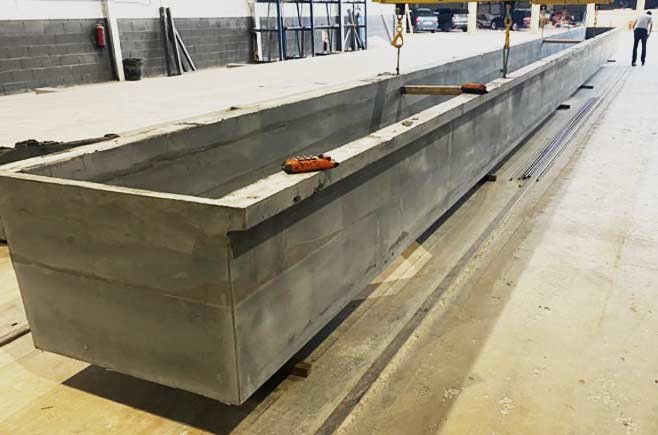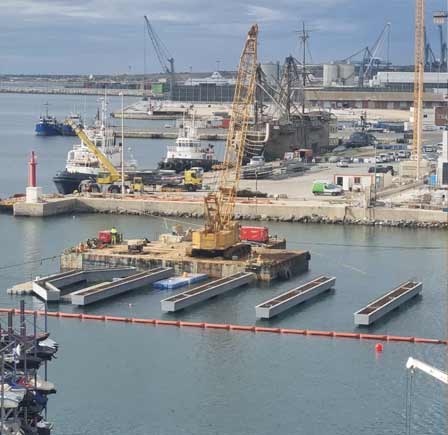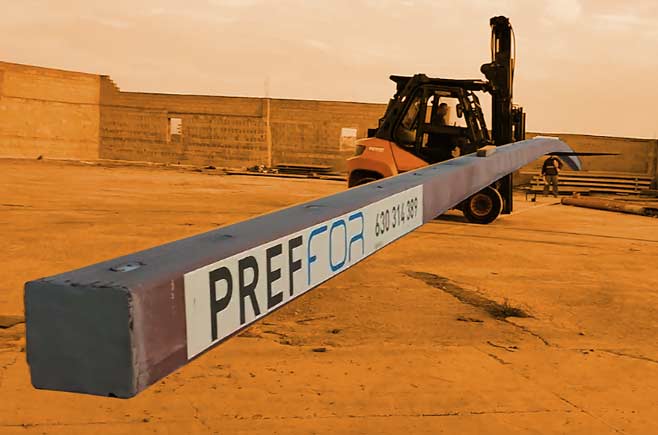Good morning!
Today I will try to elaborate an answer to the question that I launched in a LinkedIn poll few days ago: In which sector do you think that UHPC has the highest potential to grow? I divided the answer in three parts:
❶ What the audience (41 voters) answered, connecting it with their professional profile
❷ What is perspective according to the publications of researchers in conferences and international papers.
❸ What is the point of view of RDC, our engineering company, which has developed solutions for many sectors and is in continuous contact with potential clients.
The point of view of the audience
Couple of weeks ago I launched this poll in LinkedIn (RDC business profile) offering four possible sectors as an answer to the question: 1) Civil engineering, 2) Energy, 3) Architecture and modular buildings, 4) Industry. Maybe I could have added others, but I think these four embrace most of the potential applications with UHPC.
First, I would like to say that among RDC followers (currently we have 1.045 of them) we can find a good sample of experts in the field of UHPC. In a quick glance I have identified that about a 20% of them have worked with UHPC, and nearly 50% know what UHPC is. From the 41 persons that voted in our poll, I know by heart that at least 46% of them have worked actively with UHPC, and almost all the others have certain knowledge about it. Thus, the answer to the question launched can be considered a well-founded opinion, or at least a good pill of what UHPC is for the experts at global scale.
Well, according to more than half of the voters, the sector where UHPC has the highest potential to grow is in civil engineering (56%), followed by architecture and modular buildings (27%). The votes for the energy (10%) and industrial sectors (7%) are residual (see figure below).
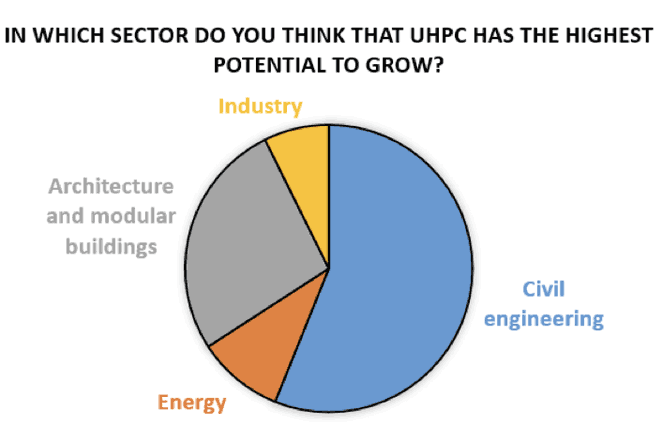
Possibly, a first explanation to this answer is that voters understand that the volume of material that could be used in civil engineering is larger than in the other sectors, so the potential to grow is higher. In fact, the greatest efforts to progress in the use of UHPC are being carried out by civil engineers, so mainly for the field of civil engineering.
The second most voted answer was Architecture and Modular Buildings, and probably because it is one of the areas where UHPC has developed more in the last years (façade panels, stairs, singular buildings…etc). On the other hand, the audience does not think that the potential of UHPC to develop in the energy and industrial sectors is significant. This may be because the existing uses of UHPC in these fields is less known and there are less efforts to develop new applications in them.
One may think that the answer to the question is affected by the profile of the voter. And I have clearly seen that this hypothesis is true. Please, observe the following table:
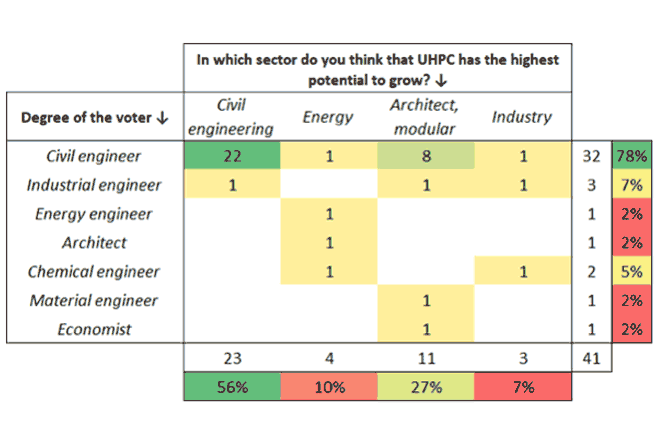
As you can see, among the people that answered, “Civil engineering”, 96% were civil engineers, while this percentage is 73% for the voters that answered, “Architecture and modular building”, and only 33% and 25% for the people that answered “Industry” and “Energy” respectively. This shows the obvious correlation between your field of expertise and your answer. This may explain the result of the survey, as 78% of the voters are civil engineers. Possibly, due to their field of expertise many of them are not aware of the potential use of UHPC in the energy and industry sectors, so for they voted for the first option. Maybe, if my LinkedIn had a majority of followers from the energy field the winning option would have been other!
If we consider the continent where the voter comes from (see table below), we can notice the higher relevance of the sector of modular building in Europe, and how the industrial applications are more known there (in fact, they were mainly developed in Denmark in the 80’ and 90’). In Asia and America, the prevalent response is that UHPC has more potential to grow in civil engineering. Possibly this shows that in these continents the needs to build and maintain infrastructures are higher than in EU, where the sector is more mature.
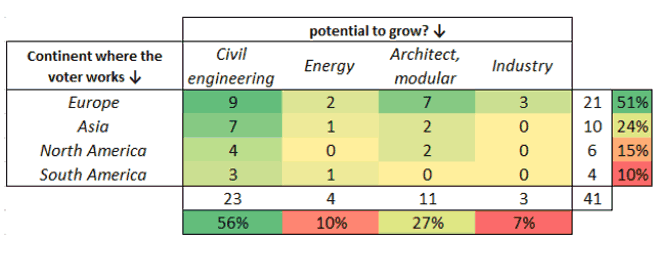
The point of view of the researchers
First, it should be considered that most of the researchers working actively with UHPC are civil engineers, which implies that there is certain trend to orient its applications on that field. Below I highlight some sentences from symposiums and journals published in recent years, which provide an overview of the perspective among researchers:
“Further expected development (deserving significant educational efforts) especially concern civil engineering facilities answering high durability and sustainability demands, light and efficient solutions for protection and structural repair, architectural achievements in façades and public buildings”.
Francois Toutlemonde, Sebastien Bernardi, Yves Brugeaud, Alain Simon. “Twenty years-long French experience in UHPFRC application and paths opened from the completion of the standards for UHPFRC”. HAL Open Science (2021).
“UHPC has ultra-high mechanical properties and ultra-high durability, which can better adapt to the current trend of large-scale and complex civil engineering structures, and meet the requirements of sustainable development for the development of high-performance materials”
Xudong Shao et. Al, Hunan University, China (2021).
“Only recently, UHPC has been placed as a thin bonded overlay for bridges in the USA. UHPC are an excelled rehabilitation method for existing bridge decks to extend their service lifetime. (….) Even though overlays are still in the infancy for UHPC applications in the US, these projects illustrate successful and high-quality installations with minimized traffic interruption”.
Peter J. Seibert, UHPC Solutions, New York, USA (2020).
“The development of UHPFRC with high tensile and compressive strength combined with an extreme high fracture energy makes it possible to make e.g. Wind Turbine Towers of heights over 200 m. An example of such a tower is the Conelto Tower, constructed of circular elements”
Jens Peder Ulfkjaer, Department of Engineering, University of Aarhus, Denmark (2020)
“Niches exist and worthwhile applications tend to increasingly grow as far as durability, aesthetics, timely opportunities for erection, possible series savings and material gains are concerned. (…). Researches and ongoing projects will thus further strengthen UHPFRC development and contribute to demonstrate their structural and architectural potential.”
Francois Toutlemonde, IFSTTAR, France (2014).
As can be seen, most of the references to the potential of UHPC applications refer to the construction and rehabilitation of civil engineering structures and architecture. Few references are done to the field of the renewable energies and rarely other sectors, as industry or aquaculture, are mentioned. This is aligned with the result of the survey, as 83% of the voters suggested that the largest potential is in civil engineering, modular building, or architecture.
The point of view of RDC
Possibly, among the sectors mentioned, the construction of civil engineering structures is the one that consumes the largest volume of material. Thus, it makes sense to state that the potential to introduce UHPC there is the largest. However, in this sector UHPC is generally proposed as an alternative to a structure that is traditionally designed with ordinary concrete or steel, being rare that UHPC provides the most economical solution from day 1. Despite that in many cases the savings in maintenance make of it the most cost-efficient option after few years, its higher initial costs are a barrier to choose it. It is difficult to pay more for something which main benefit is perceived only after years or decades.
However, there are other sectors where the benefit can be perceived earlier. In the field of floating renewable energies (offshore windfarms and floating solar), having a lighter structure significantly reduces the buoyancy required and the transportation and commissioning costs. Thus, there are more chances to propose cost-efficient solutions from day 1. An example of this are the UHPC stiffeners designed by RDC and Isigenere for the Alqueva floating solar dam (5 MW), inaugurated in 2022. Built by PREFFOR, this was not only a more durable solution than the initial proposal, but more economic and sustainable due to the significant reduction of resources used to build the precast elements.
An example of UHPC oriented to industrial applications (but not only) is Densit.

In RDC view, the high annual growth rate of the renewable energy sector is a great opportunity for the development of UHPC solutions, particularly there were traditional materials do not facilitate a cost-efficient design. Possibly this perspective is not shared by most of the people as applications in the energy sector are still in an embryonic stage, but to us, there is where UHPC really feels like a fish in the water, and its performance can be better exploited than in the construction sector.
In the case of the industry, it happens something similar. It is not well known by civil engineers, which are largest group working with UHPC (including me). There are many industrial niches where UHPC advantages can be used: Areas submitted to thermal cycles, elements submitted to a significant abrasion or fatigue, or structures submitted to an extremely acid attack. In fact, despite that many experts do not know it, these applications were developed by the Danish company Densit since the 80’, and if they installed (and install) thousands of tons of their material is because the solution proved to be competitive. To me, the potential of UHPC in the industrial sector is clear, as the economic impact of durability is much higher than in the construction sector. If nowadays UHPC is still rarely used in the industry it might be due to the lack of communication between the UHPC lobby and the industrial engineers.
Summarizing, the development of UHPC solutions beyond civil engineering requires to conceive it as something more than a construction material. We need intersectoral communication to understand the needs, and thinking out the box to imagine solutions. The potential is precisely in applications that you cannot easily imagine.

